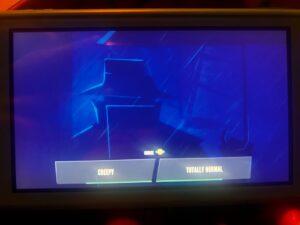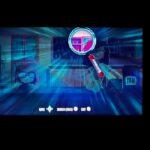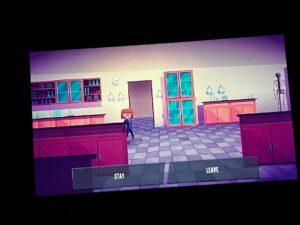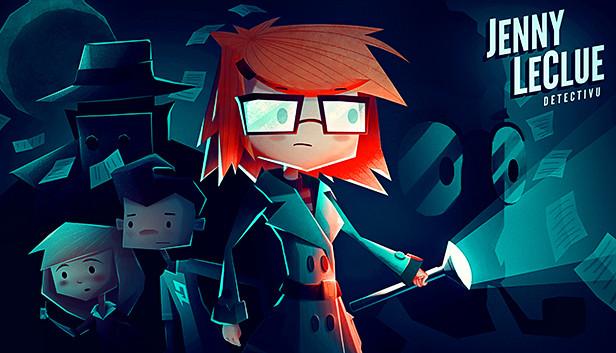For this week’s critical play, I played Jenny LeClue: Detectivú, a game made by Mografi for people who like mystery games. It is available on PC, Mac, PlayStation 4, Xbox One, iOS, Andriod, and Nintendo Switch- which I played the game on. I bought this game on sale a few months ago but did not have the chance to play it until now, so I was excited to see what it offered. I found that Jenny LeClue uses gameplay mechanics like choices and puzzles to weave narrative into the mystery and that the 2D architecture of the setting controls the story by limiting space.
 Jenny LeClue is an adventure mystery game where players can walk side to side and interact with various objects in a scene. To weave the mystery into the mechanics, the game uses many different interactive elements. The first we are introduced to are cutscene-like choices between two options that a player can make to shape the narrative. The game opens up on a mysterious figure walking through the woods who you are controlling. As you walk, instructed by the game, you reach a point where the game prompts you to whistle a tune; you can choose a creepy tune or a totally normal one. This first example is low stakes and adds humor, but it also introduces the mechanic that I would use later in the story to drive Jenny’s actions (helping her mom find her student’s tests or making up an excuse).
Jenny LeClue is an adventure mystery game where players can walk side to side and interact with various objects in a scene. To weave the mystery into the mechanics, the game uses many different interactive elements. The first we are introduced to are cutscene-like choices between two options that a player can make to shape the narrative. The game opens up on a mysterious figure walking through the woods who you are controlling. As you walk, instructed by the game, you reach a point where the game prompts you to whistle a tune; you can choose a creepy tune or a totally normal one. This first example is low stakes and adds humor, but it also introduces the mechanic that I would use later in the story to drive Jenny’s actions (helping her mom find her student’s tests or making up an excuse).
 Another mechanic is the investigation mechanic. Occasionally the player is invited to search a scene, learning more information about the narrative and looking for secrets (a gallery piece that unlocks art in the game menu, something that I am very motivated to complete now)
Another mechanic is the investigation mechanic. Occasionally the player is invited to search a scene, learning more information about the narrative and looking for secrets (a gallery piece that unlocks art in the game menu, something that I am very motivated to complete now) , with the searches providing information for the player either about the narrative or about Jenny’s working knowledge. For example, after the opening scene, we transition to the author writing about Jenny LeClue who we learn is being pressured by his publisher to change his story. The investigation scenes allow the player to figure out what he is being pressured to change about his story before he says it over the phone.
, with the searches providing information for the player either about the narrative or about Jenny’s working knowledge. For example, after the opening scene, we transition to the author writing about Jenny LeClue who we learn is being pressured by his publisher to change his story. The investigation scenes allow the player to figure out what he is being pressured to change about his story before he says it over the phone. In another instance, we play as Jenny once the author has begun writing- where she is acting as a dead
In another instance, we play as Jenny once the author has begun writing- where she is acting as a dead
 body in her mom’s detective class- and help her solve her own “murder”. This mechanic allows the player and Jenny to find clues and piece them together to figure out what happened. It is further extended with the introduction of a magnifying glass that lets Jenny investigate the world a bit closer by zooming in if there is an object of interest.
body in her mom’s detective class- and help her solve her own “murder”. This mechanic allows the player and Jenny to find clues and piece them together to figure out what happened. It is further extended with the introduction of a magnifying glass that lets Jenny investigate the world a bit closer by zooming in if there is an object of interest. These mechanics make the player feel like they can actually play detective along with Jenny, even before any actual mystery to solve appears in the game.
These mechanics make the player feel like they can actually play detective along with Jenny, even before any actual mystery to solve appears in the game.
The limited space created by the 2D side-scrolling architecture of the game helps the narrative since it limits the space that the player needs to explore and makes clues easier to spot. While playing this game, I noticed that I could spend as much time as I wanted in an area to search for clues, but I could also immediately leave once I had completed the assigned task. The fact that there was not too much to explore made me more inclined to actually try to find secrets (plus I’m going to finish that gallery), but it was also nice to see that the option to continue was there for more narrative-driven players.

This game uses repeated loops of mechanics, such as the ones mentioned above, to teach the player how to interact with its puzzles. There is a tutorial showing what buttons complete which actions the first few times you open a new puzzle, then the game expects you to learn as you play. More loops come in the interaction between Jenny LeClue and her author. Each segment of Jenny’s story is preceded by a segment of her author’s struggles. The narrative arcs of switching between characters to play (first the mysterious man, then between Jenny LeClue and her author) and switching settings with those characters drive the story forward and introduce new characters in the lives of playable characters.  These mechanics decisions drive the narrative forward, and the consistent aesthetics place the player directly in the story.
These mechanics decisions drive the narrative forward, and the consistent aesthetics place the player directly in the story.
I enjoyed playing this game for the critical play and will continue when I have some free time, but I had a slight issue with their characterization of Jenny LeClue. In an embedded storyline like this one, where players are discovering clues but the game direction is structured, I think it is important to have a likable or redeemable protagonist. However, I think Jenny LeClue might be my least favorite character in this game. Luckily she interacts with enough other people that I don’t mind too much.




